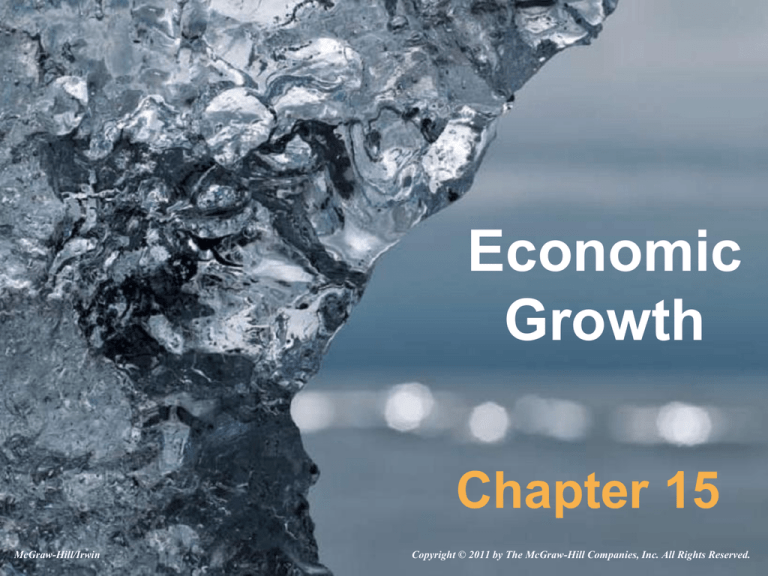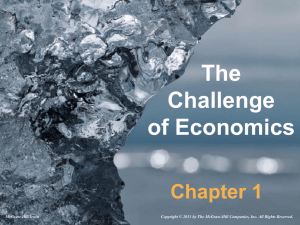
Economic
Growth
Chapter 15
McGraw-Hill/Irwin
Copyright © 2011 by The McGraw-Hill Companies, Inc. All Rights Reserved.
The Nature of Growth
• Economic growth refers to increases
in the output of goods and services
(real GDP)—an expansion of
production possibilities.
• Improvements in output may result
from:
– Increased use of existing capacity
OR
– Increases in that capacity itself
LO-1
15-2
Short-Run Changes
in Capacity Use
• The easiest kind of growth comes from
increased use of our productive
capacity.
• We do not always take full advantage
of our productive capacity.
LO-1
15-3
Short-Run Changes
in Capacity Use
• Productive capacity is illustrated by the
production possibilities curve:
– Production possibilities are the
alternative combinations of goods and
services that could be produced in a given
time period with all available resources
and technology
LO-1
15-4
Long-Run Changes
in Capacity
• To achieve large and lasting increases
in output, we must push our production
possibilities outward.
• Economists tend to define economic
growth in terms of changes in potential
GDP.
LO-1
15-5
Figure 15.1
15-6
Aggregate Supply
Focus
• Economic growth—sustained
increases in total output—is possible
only if the AS curve shifts rightward.
LO-1
15-7
Figure 15.2
15-8
Nominal versus
Real GDP
• Nominal GDP is the total value of
goods and services produced within a
nation’s borders, measured in current
prices.
• Real GDP is the inflation-adjusted
value of GDP or the value of output
measured in constant prices.
LO-1
15-9
The GDP Growth Rate
• Growth rate is the percentage change
in real GDP from one period to
another.
• The challenge for the future is to
maintain higher rates of economic
growth.
change in real GDP
Growth Rate =
base period GDP
LO-1
15-10
The GDP Growth Rate
• The past decade saw a period of
economic growth even with recessions
in 2001 and 2008-09.
• Population growth is not a guarantee of
economic growth.
Growth Rate
=
change in real GDP
base period GDP
LO-1
15-11
Figure 15.3
15-12
The Exponential
Process
• Even one year of “low” growth implies
lost output.
• Economic growth is a continuing
process where gains made in one year
accumulate in future years.
• This cumulative process is called an
exponential process.
LO-1
15-13
GDP per Capita:
Measure of Living Standards
• GDP per capita–total GDP divided by
total population or average GDP.
• Growth in GDP per capita is attained
only when the growth of output
exceeds population growth.
• U.S. GDP per capita has more than
doubled since Ronald Reagan was
elected president.
LO-2
15-14
GDP per Worker:
A Measure of Productivity
• Average workers today produce nearly
twice as much as their parents did.
• The U.S. labor force grew faster than
the population during the 1990s:
– The labor force includes all persons over
age 16 who are either working for pay or
actively seeking paid employment.
LO-2
15-15
GDP per Worker:
A Measure of Productivity
• The U.S. employment rate also
increased:
– The employment rate is the proportion of
the population that is employed.
LO-2
15-16
GDP per Worker:
A Measure of Productivity
• If productivity is increasing, then per
capita GDP is likely to rise as well.
– Productivity is output per unit of input,
such as output per labor hour.
LO-2
15-17
Figure 15.4
15-18
Sources of
Productivity Growth
• The sources of productivity gains
include:
– Higher skills
– More capital
– Improved management
– Technological advance
LO-3
15-19
Labor Quality
• As education and training levels rise,
so does productivity.
LO-3
15-20
Capital Investment
• Capital investment is a prime
determinant of both productivity and
growth:
– Investment refers to expenditures on
(production of) new plant and equipment
(capital) in a given time period, plus
changes in business inventories.
LO-3
15-21
Management
• Entrepreneurship and the quality of
continuing management are major
determinants of economic growth.
• There is a potential conflict between
short-term profits and long-term
productivity gains.
• Managers must develop personnel
structures and incentives that make
employees contribute to production.
LO-3
15-22
Research and
Development
• Research and Development (R&D) is a
broad concept that includes:
– Scientific research
– Product development
– Innovations in production technique
– Development of management
improvements
LO-3
15-23
Policy Levers
• Government policies can have a major
impact on whether and how far the
aggregate supply curve shifts.
LO-4
15-24
Education and Training
• Government policies that support
education and training have a dual
payoff:
– They stimulate the economy in the short
run
– They increase the long-run capacity to
produce
LO-4
15-25
Immigration Policy
• The quality and quantity of labor are
affected by immigration policy because:
– It is a direct contributor to an outward shift
of our production possibilities
– Recent immigrants have much lower
educational attainments than native-born
Americans
LO-4
15-26
Investment Incentives
• Tax policy is not only a staple of shortterm stabilization policy, but a
determinant of long-run growth as well.
• The tax treatment of capital gains is
one of the most debated supply-side
policy levers.
LO-4
15-27
Savings Incentives
• Supply-side economists favor tax
incentives that encourage saving as
well as greater tax incentives for
investment:
– Saving is that part of disposable income
not spent or income minus consumption.
– By 2006, the U.S. saving rate was
negative as consumers were spending
more than they were earning.
LO-4
15-28
Saving Ratings
15-29
Government Finances
• When government borrows to finance
its spending, it dips into the nation’s
savings pool.
• Crowding out is a reduction in privatesector borrowing (and spending)
caused by increased government
borrowing.
LO-4
15-30
Government Finances
• Crowding in is an increase in privatesector borrowing (and spending)
caused by decreased government
borrowing.
• Fiscal and monetary policies must be
evaluated in terms of their impact not
only on short-run aggregate demand
but also on long-run aggregate supply.
LO-4
15-31
Deregulation
• Government regulations impact
aggregate supply by:
– Limiting the flexibility of producers to
respond to changes in demand.
– Raising production costs.
LO-4
15-32
Factor Markets
• Regulation of factor markets include:
– Minimum-wage laws
– Occupational Safety and Health
Administration (OSHA) standards
• More people would be hired without
regulation
LO-4
15-33
Product Markets
• Regulation of product markets include:
– Transportation costs
– Food and drug standards
• Regulation causes restricted supply
• The basic contention of supply-side
economists is that regulatory costs are
too high.
LO-4
15-34
Economic Freedom
• Nations with the most economic
freedom have the highest GDP per
capita and grow the fastest.
LO-5
15-35
Is More Growth
Desirable?
• More growth can lead to:
– Congestion
– Air pollution
– Depleted natural resources
• The debate usually centers around the
mix of goods and services being
provided rather than the quantity of
output.
LO-5
15-36
End of
Chapter 15








